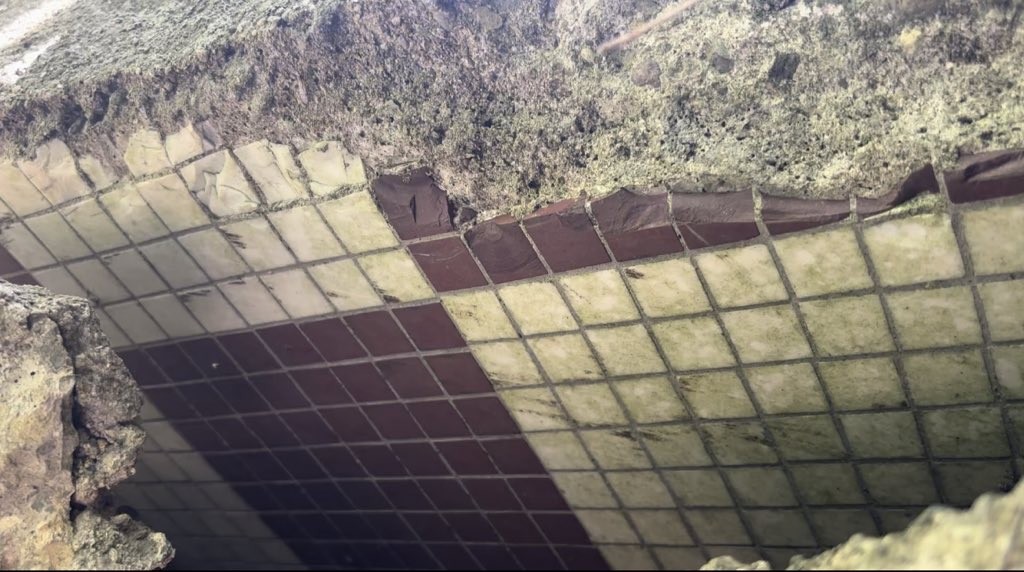INDIANAPOLIS — Broad Ripple Park is a far cry from what it used to be decades ago. At one point, Broad Ripple Amusement Park filled the grassy fields of the 60-acre park and was called “Indiana’s Greatest Playground.”
Roller coasters, a dance hall, maybe even a lion filled the amusement park for years in the first decades of the 1900s. The main attraction was the gargantuan Broad Ripple Pool. At the time, it was possibly the biggest in the world.
A brochure on the park saved by the Indiana Historical Society boasts the pool was the biggest in the world at the time. It was 450 feet by 207 feet and had a capacity of 4.3 million gallons of water. Pictures saved by IHS show the pool with slides, diving towers, an island in the middle and grandstands large enough to hold 3,500 people.








Pictures courtesy of Bass Photo Co Collection, Indiana Historical Society and Indiana Historical Society, P0569
Few still remember the park in all of its glory. Former Indiana University swimmer and longtime leader within U.S. Masters Swimming Mel Goldstein grew up in Butler Tarkington and went to the park in his childhood during the 1940s and 1950s.
”I started swimming competitively when I was 12 and swam what was the Indy Times Junior Olympics in this pool and then have swam ever since,” Goldstein said.
Eventually, he was spending every day of the summer at the Broad Ripple Pool. What does he remember the most?
”It was cold,” Goldstein said, laughing. “The water was always cold because they always got the water from the river.”
Not only was it cold, but documents from the time claim it was safe to drink!
“In fact, they claimed that through the sanitation process, they encouraged you to drink the water,” said Suzanne Hahn, the Vice President of Archives and Library at the Indiana Historical Society.
The size of the pool was out to the test during one especially hot summer in the 1920s.
”One afternoon they counted 1600 people, and I just can’t imagine it filled with that many bodies,” said Amy Vedra, Director of Reference Services at the Indiana Historical Society, said
The Broad Ripple Pool just wasn’t an attraction for swimmers, though, it was a competition pool. Even with its size, it could be set up to have the same lane dimensions as everywhere else.
”The pool also was so large and really state of the art, that it also brought competitive folks to that area for competitions including the Olympic Trials,” said Hahn.
1924 was the biggest event yet for the Broad Ripple Pool, the 1924 U.S. Olympic Swim Trials. A century later and history is repeating itself. Indy is once again hosting the trials in 2024.
The similarities don’t end there, though. Athletes from both trials will travel to Paris for the Olympics. Both trials also featured unusual venues.
In 1924, the Broad Ripple Pool was considered one of the biggest, if not the biggest pool in the world. Now in 2024, the Olympic trials competition and practice pools inside Lucas Oil Stadium mark the first time a swimming competition has been held in a football stadium.
”Now they’re taking this state-of-the-art football stadium and making it a swimming venue, which is in and of itself very cool, so I think that same kind of awe that comes about those large events exists for both a century apart,” said Vedra.
But, which pool is bigger? As he’s seen both, Goldstein has the answer.
”And you can set that pool inside of this pool,” said Goldstein, pointing at the spot behind him in Broad Ripple Park where the pool used to be.
A brochure preserved by the Indiana Historical Society says the Broad Ripple Pool had a capacity of 4.3 million gallons of water. That is more than twice the water it takes to fill both the practice and competition pool inside Lucas Oil Stadium.
Another fun fact, the water for both pools came from the White River. The water was pumped into the Broad Ripple pool from the river right next to it. For the Lucas Oil pools, water was pulled from a hydrant right outside the stadium. The water from that hydrant originated in the White River.
”We talk a lot about in our profession how history repeats itself and this is certainly an example,” Hahn said.
Where the Broad Ripple Pool and Amusement Park used to sit is now a baseball field, tennis courts, recycling dumpsters and a large grass field. Goldstein can still point out where everything used to be.
”At the trees out there that’s where all grandstands were,” he said. “Covered the entire length of the pool. This area here close to us was predominantly the baby pool. One year or two years that I was around it was filled with sand so it was kind of a beach that was a pool.”
If you look hard enough, you can still find possibly the last remnants of the long-gone Broad Ripple Pool in the park.
There is a small bridge along a gravel trail just off a parking lot in the Broad Ripple Park. If you jump down under the bridge and look in the cracks of the stone making the walkway you’ll find old red and white tile.
Goldstein confirms it’s what he saw every summer at the Broad Ripple pool.
“Yes, exactly,” he said. “Little bitty square tiles.”
But, he thinks those might not be the only tiles to have been saved from the pool demolition and scattered about the park.
”If you walk down toward the river, there are places you might find bigger pieces or other pieces that are that big,” Goldstein said.
History repeats itself this Saturday as the U.S. Olympic Swim Trials get started in Indy once again, this time 10 miles south from Broad Ripple in the heart of downtown Indy.

